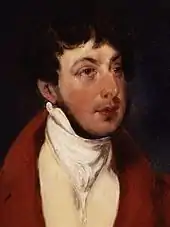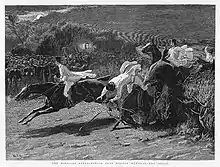Quorn Hunt
The Quorn Hunt, usually called the Quorn, established in 1696, is one of the world's oldest fox hunting packs and claims to be the United Kingdom's most famous hunt. Its country is mostly in Leicestershire, together with some smaller areas of Nottinghamshire and Derbyshire.
 Frank Hall Standish with the Quorn Hunt, by John Ferneley, Snr, 1819 | |
| Hunt type | Fox hunting |
|---|---|
| Country | |
| History | |
| Founded | 1696 |
| Founded by | Mr Thomas Boothby |
| Hunt information | |
| Hound breed | Foxhound |
| Hunt country | Leicestershire |
| Master(s) | Joss Hanbury, James Mossman, Mrs Nicky Hanbury, the Hon. Mrs Amanda Eastwood, Rowan Cope, and Paul Ikin (jointly) |
| Huntsman | Mr Ollie Finnegan |
| Whipper(s)-in | Mr Russell Lindsay |
| Quarry | Fox |
| Kennelled | Kirby Bellars |
| Website | www.quorn-hunt.co.uk |
Despite the abolition of fox hunting intended by the Hunting Act 2004, the Quorn continues to go out on four days of the week during the autumn and winter months.
History
The hunt traces its origins to a pack of foxhounds established in 1696 at Tooley Park, Leicestershire, by the youthful Thomas Boothby (1677–1752). Its present name comes from the village of Quorn, also known as Quorndon, where the hounds were kennelled between 1753 and 1904.[1] They were established there by the hunt's second master, Hugo Meynell, who bought Quorndon Hall from the 4th Earl Ferrers.[2] Following more than half a century under the leadership of Boothby, Meynell was Master for forty-seven years. He was known for his innovative mastery of fox hunting so that he has been called 'The Primate of the Science'.[3]
In 1905, new kennels and stables were built at Paudy Lane, Seagrave; these are now listed buildings.[4] The hunt's present-day kennels are at Gaddesby Lane, Kirby Bellars, near Melton Mowbray.[5]

Among many notable Masters was George Osbaldeston, who in 1823 became the first to return to the Mastership after having previously retired.[6]
Before gaining its present title in the mid-19th century, the hunt was often known by the name of its Master: for instance, from 1827 to 1831 it was called 'Lord Southampton's Hounds'. Until 1884, the hounds were owned by the Master, and a change of mastership took place either by purchase or inheritance.[7] The hounds are now said to be "owned by the country", that is, by the hunt organization.[8]
In 1890, Algernon Burnaby and Count Eliot Zborowski together planned the Quorn Hunt's famous Midnight Steeplechase, a jumping race in the middle of the night over twelve furlongs, with the riders dressed in nightshirts and top hats and the fences lit by oil lamps. Burnaby was the triumphant winner, gaining a silver cup provided by Zborowski. The race is commemorated in sporting prints.[9]
A Great Depression began in 1929, and subscriptions to the hunt began to fall. Burnaby, Master since 1912, recruited Sir Harold Nutting of Quenby Hall, "newly rich from bottling Guinness", as his joint Master, and quipped "We don't want your personality, we want your purse!" Jane Ridley has estimated that during the following ten years Nutting spent about £15,000 a year on the Quorn.[10]
Three Hunt-class warships of the Royal Navy have been called HMS Quorn, after the Hunt.[11]
Country
The Quorn hunts a wide area of Leicestershire, plus some coverts in Nottinghamshire and Derbyshire, stretching from just south of Nottingham to the edge of the city of Leicester and from Melton Mowbray westwards to Ashby de la Zouch. On the eastern side of the country lies a rolling open landscape, with good fences to jump, while to the west are the wooded uplands of Charnwood Forest and the Pennine Chain. The best centres are around Melton Mowbray, Leicester and Loughborough.[1][8]
In 1853, the southern part of its country was separated off to form the Fernie.
The adjoining hunts are the Meynell and South Staffs (to the north west), the South Notts (to the north), the Belvoir (to the north east), the Cottesmore (to the south east), the Fernie (to the south), and the Atherstone (to the south west).[8]
Season and supporters
Hunting takes place on Mondays, Tuesdays, Fridays and Saturdays, in the autumn and winter months only. More open country is hunted on Mondays and Fridays, the most popular days, with usually between one hundred and one hundred and fifty mounted followers, plus about twice as many who follow hounds on foot and with cars and bicycles. The smallest number of followers is on Tuesdays. Over eight hundred farmers in the country of the Quorn allow the hunt to use their land.[1] There is a Supporters' Association.[12]
The hunt's 'Saturday Country' is around Belton, Staunton Harold and Kingston and has its own 'Saturday Country Wire and Damage Fund'.[13]
List of Masters
|
 A future Master, Algernon Burnaby, winning the Midnight Steeplechase of 1890
|
Post-ban
Although "hunting wild mammals with a dog" was made unlawful in England and Wales by the Hunting Act 2004, which came into effect in 2005,[14] the Quorn Hunt says that it continues to operate within the law.[15] A number of exemptions stated in Schedule 1 of the 2004 Act permit some previously unusual forms of hunting wild mammals with dogs to continue, such as "hunting... for the purpose of enabling a bird of prey to hunt the wild mammal".[16]
Quorn Hunt Ball
There is also an annual Quorn Hunt Ball. In 2014, it took place at Two Temple Place in London[17][18] but there is also one hosted in Leicestershire each year.
Bibliography
- William Charles Arlington Blew, The Quorn Hunt and its masters, with illustrations by Henry Alken (London: John C. Nimmo, 1899)[19]
- William Scarth Dixon, The Quorn Hunt
- Lady Augusta Fane, Chit-Chat (London: Thornton Butterworth, 1926)
- Daphne Machin Goodall, Huntsmen of the Golden Age (London: H.F. & G. Witherby, 1956)
- Roy Heron, Tom Firr of the Quorn, Huntsman Extraordinary (Liss: Nimrod Book Services, 1984)
- Ulrica Murray-Smith, Magic of the Quorn (London: J. A. Allen & Co., 1980)
- J. Otho Paget, Memories of the Shires (Methuen, 1920, republ. 2012)
- "Cecil", The Quorn Hunt: the Accustomed Places of Meeting, with Distances from Railway Stations, circa 1870
References
- About the Hunt Archived 11 December 2009 at the Wayback Machine page at quornhunt.co.uk
- William C. A. Blew, The Quorn Hunt and Its Masters (1899), p. 23
- Blew, op. cit., p. 47
- Quorn Hunt Kennels and Stabling, Quorn Park, Seagrave (Grade II) at charnwood.gov.uk
- Quorn Hunt Kennels at yell.com
- Blew, op. cit., Chapter IV at archive.org: 'Mr George Osbaldeston 1817–1821, 1823–1827'
- Blew, op. cit., passim
- Quorn Hunt at mfha.org.uk
- William Arthur Deakin, 19th century Loughborough: a review of the past century (Loughborough: Echo Press Ltd, 1974), p. 74
- Pamela Horn, Country House Society: the Private Lives of England's Upper Class after the First World War, p. 123
- HMS Quorn Archived 20 September 2011 at the Wayback Machine at royalnavy.mod.uk
- QH Supporters Association Archived 19 August 2010 at the Wayback Machine at quornhunt.co.uk
- Saturday Wire Fund Club Archived 9 January 2010 at the Wayback Machine at quornhunt.co.uk
- Hunting Act 2004 Archived 7 April 2009 at the Wayback Machine, text online at opsi.gov.uk
- Home page Archived 28 August 2008 at the Wayback Machine at quornhunt.co.uk
- Stephen Moss, "The banned rode on: Eighteen months ago hunting was banned. Or was it?" from The Guardian dated 7 November 2006, at guardian.co.uk, accessed 29 April 2013
- The Quorn Hunt Ball, Tatler, 22 April 2015
- Quorn Hunt Party, Nico Morgan Media, 22 November 2014
- OCLC 1061884100 (all editions), outline at archive.org, accessed 6 August 2019
External links
- quorn-hunt.co.uk - official web site
- Quorn Hunt photos at Nico Morgan Media
- Captain Tommy Burns Hartopp at antique-prints.co.uk
